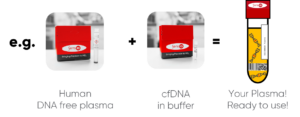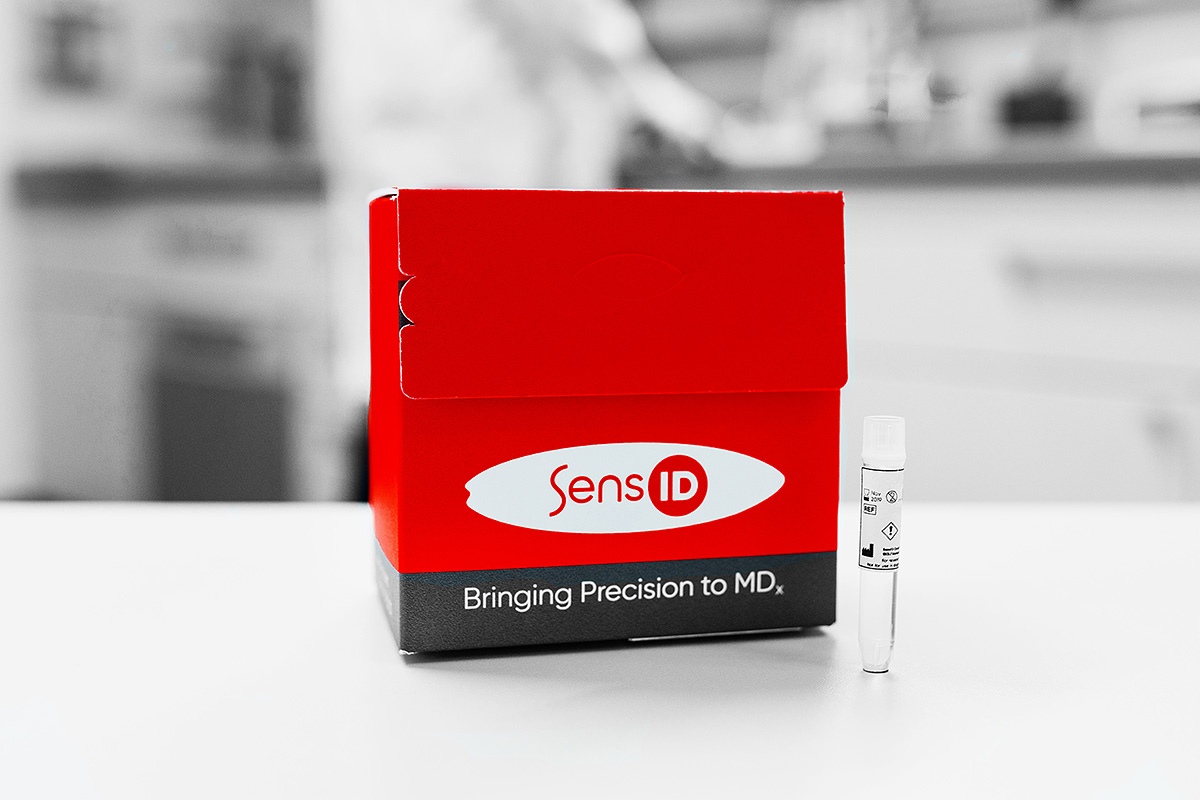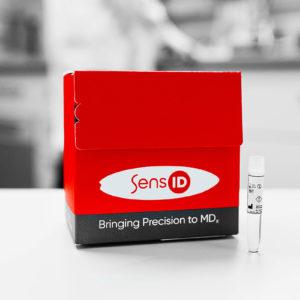Product description
Also available as a customized product tailored to your needs!
OEM options:
If you need materials as in kit controls or as a third-party control for validation of your kits at customer labs, please contact us via: sales@sens-id.com
How to create your full workflow plasma control material based on this product:
We recommend the use of our human DNA-free plasma products to produce complete workflow controls with this product. Blend the cfDNA as necessary with the DNA depleted plasma to receive plasma materials with the necessary DNA concentrations.

Choose your plasma volume options :
These products are ideal for digital PCR and/or Next Generation Sequencing (NGS). In particular:
– Validation and development of sequencing protocols (e.g. Whole Genome Sequencing (WGS), Amplicon Sequencing) and PCR protocols
– Determination of the detectiont limit of the method
Unit Size:
400 ng
Concentration:
20 ng/µl
Mutations:
- AKT1 – p.E17K (COSV62571334*, Substitution, c.49G>A)
- BRAF – p.V600E (COSV56056643*, Substitution, c.1799T>A)
- ERBB2 – p.Y772_A775dup (COSV54062409*, Insertion, c.2313_2324dup)
- KRAS – p.G12D (COSV55497369*, Substitution, c.35G>A)
- KRAS – p.Q61K (COSV55502066*, Substitution, c.181C>A)
- KRAS – p.A146T (COSV55501778*, Substitution, c.436G>A)
- PIK3CA – p.E545K (COSV55873239*, Substitution, c.1633G>A)
- PIK3CA – p.H1047R (COSV55873195*, Substitution, c.3140A>G)
Allele frequency:
0.1%
Buffer:
Tris-EDTA (10 mM Tris, 1 mM EDTA), pH 8.0
Storage:
2-8 °C
Expiry:
stable for 24 months from date of manufacture (as supplied)
Quality control
Fragmentation size:
Elektrophoresis-Bioanalyzer-High Sensitivity DNA Kit Agilent
Allele Frequency / copies (metrologically traceable):
dPCR
Quantification (metrologically traceable):
- UV-Vis Spectrophotometry (NIST-Reference method) measurement of total DNA
- fluorometric dsDNA measurement
Technical background
Derived from:
cell line GM24385 (HG002- NA24385 – huAA53E0)
Bioinformatics:
– lot specific sequencing files: LOT Search
– High-confidence variant calls: ftp://ftp-trace.ncbi.nlm.nih.gov/giab/ftp/release/AshkenazimTrio
– Raw datasets and bam files, currently including 10X Genomics, BioNano, Complete Genomics regular and LFR, 300x Illumina paired-end, Illumina 6kb mate-pair, 1000x Ion exome, custom molecular libraries, ~0.05x Oxford Nanopore, and 70x/30x/30x PacBio: ftp://ftp-trace.ncbi.nlm.nih.gov/giab/ftp/data/AshkenazimTrio/HG002_NA24385_son/
*GRCh 38 Cosmic v90
Documents
Certificate of Analysis:
Batch Certificate

Lot: 00019 | 00095 | 00138 | 00495 | 00701

other Documents:
Instructions for use

Safety Data Sheet (SDS in other languages available on request. Please contact the support.)

Infos on mutations
PIK3CA testing is a critical component of Breast Cancer management. PIK3CA is a predictive biomarker for use of alpelisib and fulvestrant in patients. Only patients with a PIK3CA mutation are eligible for biomarker-driven therapy with PIQRAY. PIK3CA mutations can be detected in tissue or plasma specimens.
BRAF V600E is a predictive biomarker for use of vemurafenib, dabrafenib, trametinib, cetuximab, panitumumab, binimetinib, encorafenib, cobimetinib, imatinib, and sunitinib in patients. There are 6 FDA approvals and 9 NCCN guidelines that support the use of a targeted therapy based on the presence of BRAF V600E. Colorectal carcinoma, melanoma, non-small cell lung carcinoma, gastrointestinal stromal tumor, and hairy cell leukemia have the most therapies targeted against BRAF V600E or its related pathways.
KRAS is a predictive biomarker for use of cetuximab, panitumumab, afatinib, dacomitinib, erlotinib, gefitinib, and osimertinib in patients. Non-small cell lung carcinoma and colorectal carcinoma have the most therapies with KRAS as a predictive biomarker.
ERBB2 is a predictive biomarker for use of trastuzumab, aromatase inhibitor, docetaxel, paclitaxel, pertuzumab, ribociclib, abemaciclib, carboplatin, everolimus, exemestane, fulvestrant, lapatinib, trastuzumab emtansine, capecitabine, cisplatin, letrozole, palbociclib, alpelisib, anastrozole, atezolizumab, endocrine therapy, fluorouracil, nab-paclitaxel, neratinib, olaparib, talazoparib, taxane compound, and trastuzumab/hyaluronidase-oysk in patients. Breast carcinoma, adenocarcinoma of the gastroesophageal junction, gastric carcinoma, malignant esophageal neoplasm, and non-small cell lung carcinoma have the most therapies with ERBB2 as a predictive biomarker.
| Official Symbol |
AKT1 |
| Official Full Name |
AKT serine/threonine kinase 1 |
| Organism |
Homo sapiens |
| Also known as |
AKT; PKB; RAC; CWS6; PRKBA; PKB-ALPHA; RAC-ALPHA |
| Summary |
The serine-threonine protein kinase encoded by the AKT1 gene is catalytically inactive in serum-starved primary and immortalized fibroblasts. AKT1 and the related AKT2 are activated by platelet-derived growth factor. The activation is rapid and specific, and it is abrogated by mutations in the pleckstrin homology domain of AKT1. It was shown that the activation occurs through phosphatidylinositol 3-kinase. In the developing nervous system AKT is a critical mediator of growth factor-induced neuronal survival. Survival factors can suppress apoptosis in a transcription-independent manner by activating the serine/threonine kinase AKT1, which then phosphorylates and inactivates components of the apoptotic machinery. Mutations in this gene have been associated with the Proteus syndrome. Multiple alternatively spliced transcript variants have been found for this gene. [provided by RefSeq, Jul 2011] |
| Official Symbol |
BRAF |
| Official Full Name |
B-Raf proto-oncogene, serine/threonine kinase |
| Organism |
Homo sapiens |
| Also known as |
NS7; B-raf; BRAF1; RAFB1; B-RAF1 |
| Summary |
This gene encodes a protein belonging to the RAF family of serine/threonine protein kinases. This protein plays a role in regulating the MAP kinase/ERK signaling pathway, which affects cell division, differentiation, and secretion. Mutations in this gene, most commonly the V600E mutation, are the most frequently identified cancer-causing mutations in melanoma, and have been identified in various other cancers as well, including non-Hodgkin lymphoma, colorectal cancer, thyroid carcinoma, non-small cell lung carcinoma, hairy cell leukemia and adenocarcinoma of lung. Mutations in this gene are also associated with cardiofaciocutaneous, Noonan, and Costello syndromes, which exhibit overlapping phenotypes. A pseudogene of this gene has been identified on the X chromosome. [provided by RefSeq, Aug 2017] |
| Official Symbol |
ERBB2 |
| Official Full Name |
erb-b2 receptor tyrosine kinase 2 |
| Organism |
Homo sapiens |
| Also known as |
NEU; NGL; HER2; TKR1; CD340; HER-2; MLN 19; HER-2/neu |
| Summary |
This gene encodes a member of the epidermal growth factor (EGF) receptor family of receptor tyrosine kinases. This protein has no ligand binding domain of its own and therefore cannot bind growth factors. However, it does bind tightly to other ligand-bound EGF receptor family members to form a heterodimer, stabilizing ligand binding and enhancing kinase-mediated activation of downstream signalling pathways, such as those involving mitogen-activated protein kinase and phosphatidylinositol-3 kinase. Allelic variations at amino acid positions 654 and 655 of isoform a (positions 624 and 625 of isoform b) have been reported, with the most common allele, Ile654/Ile655, shown here. Amplification and/or overexpression of this gene has been reported in numerous cancers, including breast and ovarian tumors. Alternative splicing results in several additional transcript variants, some encoding different isoforms and others that have not been fully characterized. [provided by RefSeq, Jul 2008] |
| Official Symbol |
KRAS |
| Official Full Name |
KRAS proto-oncogene, GTPase |
| Organism |
Homo sapiens |
| Also known as |
NS; NS3; OES; CFC2; RALD; K-Ras; KRAS1; KRAS2; RASK2; KI-RAS; C-K-RAS; K-RAS2A; K-RAS2B;
K-RAS4A; K-RAS4B; c-Ki-ras2 |
| Summary |
This gene, a Kirsten ras oncogene homolog from the mammalian ras gene family, encodes a protein that is a member of the small GTPase superfamily. A single amino acid substitution is responsible for an activating mutation. The transforming protein that results is implicated in various malignancies, including lung adenocarcinoma, mucinous adenoma, ductal carcinoma of the pancreas and colorectal carcinoma. Alternative splicing leads to variants encoding two isoforms that differ in the C-terminal region. [provided by RefSeq, Jul 2008] |
| Official Symbol |
PIK3CA |
| Official Full Name |
phosphatidylinositol-4,5-bisphosphate 3-kinase catalytic subunit |
| Organism |
Homo sapiens |
| Also known as |
MCM; CWS5; MCAP; PI3K; CLAPO; CLOVE; MCMTC; PI3K-alpha; p110-alpha |
| Summary |
Phosphatidylinositol 3-kinase is composed of an 85 kDa regulatory subunit and a 110 kDa catalytic subunit. The protein encoded by this gene represents the catalytic subunit, which uses ATP to phosphorylate PtdIns, PtdIns4P and PtdIns(4,5)P2. This gene has been found to be oncogenic and has been implicated in cervical cancers. A pseudogene of this gene has been defined on chromosome 22. [provided by RefSeq, Apr 2016] |
References:
https://www.ncbi.nlm.nih.gov/gene/673
https://www.ncbi.nlm.nih.gov/gene/5290
https://www.ncbi.nlm.nih.gov/gene/3845
https://www.ncbi.nlm.nih.gov/gene/207
https://www.ncbi.nlm.nih.gov/gene/2064
https://www.hcp.novartis.com/products/piqray/metastatic-breast-cancer/pik3ca-mutation/
https://www.mycancergenome.org/content/gene/pik3ca/#ref-2
https://www.mycancergenome.org/content/alteration/braf-v600e/
https://www.mycancergenome.org/content/gene/kras/
https://www.mycancergenome.org/content/gene/erbb2/






